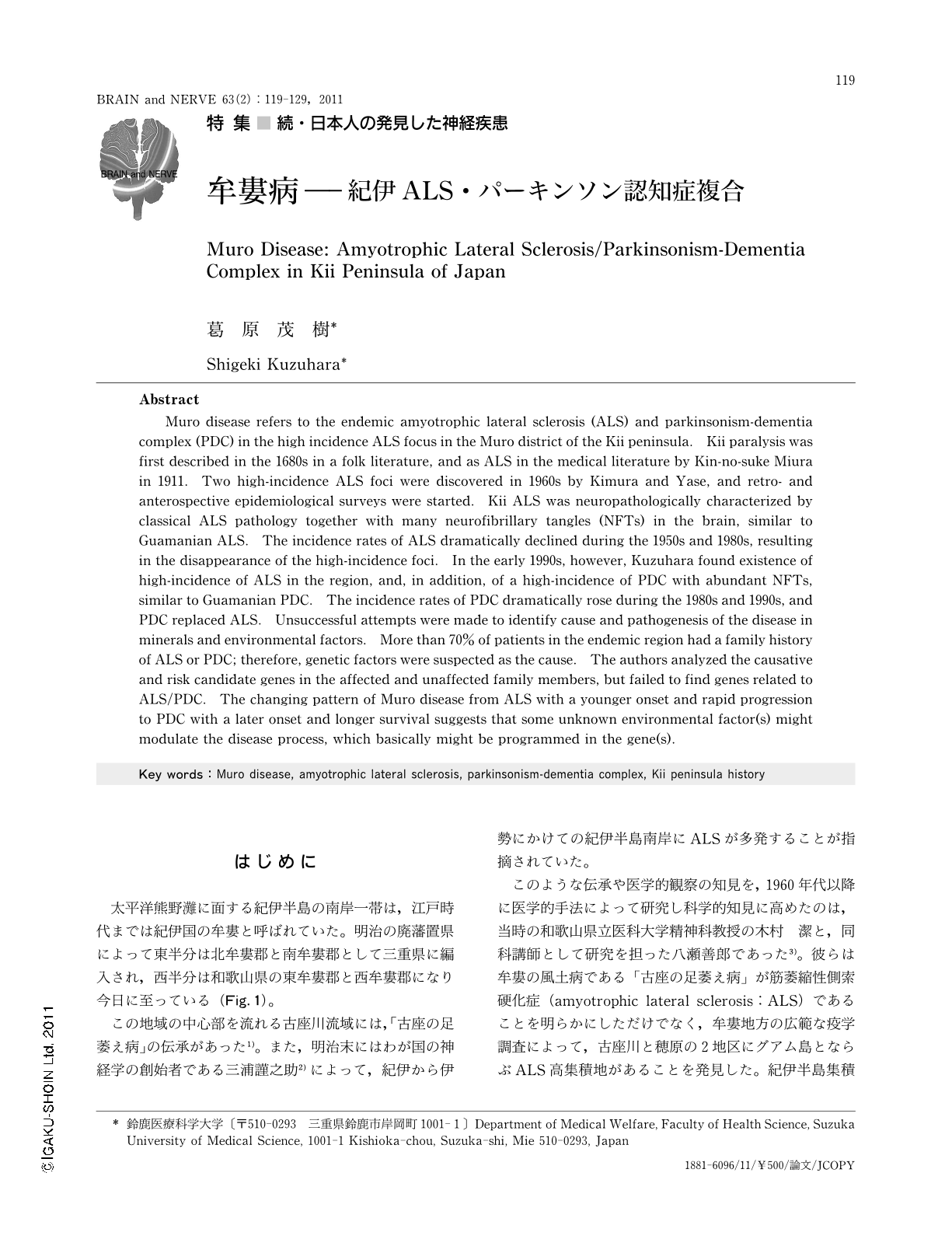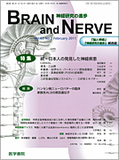Japanese
English
- 有料閲覧
- Abstract 文献概要
- 1ページ目 Look Inside
- 参考文献 Reference
はじめに
太平洋熊野灘に面する紀伊半島の南岸一帯は,江戸時代までは紀伊国の牟婁と呼ばれていた。明治の廃藩置県によって東半分は北牟婁郡と南牟婁郡として三重県に編入され,西半分は和歌山県の東牟婁郡と西牟婁郡になり今日に至っている(Fig.1)。
この地域の中心部を流れる古座川流域には,「古座の足萎え病」の伝承があった1)。また,明治末にはわが国の神経学の創始者である三浦謹之助2)によって,紀伊から伊勢にかけての紀伊半島南岸にALSが多発することが指摘されていた。
このような伝承や医学的観察の知見を,1960年代以降に医学的手法によって研究し科学的知見に高めたのは,当時の和歌山県立医科大学精神科教授の木村 潔と,同科講師として研究を担った八瀬善郎であった3)。彼らは牟婁の風土病である「古座の足萎え病」が筋萎縮性側索硬化症(amyotrophic lateral sclerosis:ALS)であることを明らかにしただけでなく,牟婁地方の広範な疫学調査によって,古座川と穂原の2地区にグアム島とならぶALS高集積地があることを発見した。紀伊半島集積地のALS(紀伊ALS)は神経病理学的には中枢神経系にAlzheimer神経原線維変化[Alzheimer neurofibrillary change (tangle):NFT]が多発し,グアムALSと同質の疾患と考えられた4)。
紀伊ALSの疫学と原因研究は,八瀬をリーダーとして米国のグアム病研究グループと共同で進められたが,原因解明がなされないままにグアムに引き続いて紀伊半島でもALSの発生が激減していき,1980年代にはこれらの地域での高頻度発生は終焉したことが報告された5,6)。
1990年に三重大学に神経内科が新設され,教授として着任した筆者7)は,かつて高集積地であった穂原地区から1年間に3名のALS患者が受診したことを契機に再調査を行い,ALS多発がなおも持続していることを確認しただけでなく,同じ集落にグアムのパーキンソン・認知症複合(parkinsonism-dementia complex:PDC)に臨床像が酷似した疾患も多発していることを観察し,剖検例によって神経病理学的にも確定した。紀伊ALSとPDCは臨床病理学的には同じスペクトル上の疾患と考えられており,ALS/PDCとして扱われることが多い。多発の原因に関しては,環境因,遺伝素因ともに解明されていない。
時間軸でみると,紀伊半島でもグアム島でも,ALS発生は激減し,PDCは減少しながらも持続しているが,近年は高齢者認知症が増加していることが報告されている8)。このような疫学像の変遷が何によってもたらされたのかは,ALSの成因や予防との関連で大きな関心が払われている。本稿ではこのような筋書きに沿って,牟婁病の歴史を振り返ってみたい。
Abstract
Muro disease refers to the endemic amyotrophic lateral sclerosis (ALS) and parkinsonism-dementia complex (PDC) in the high incidence ALS focus in the Muro district of the Kii peninsula. Kii paralysis was first described in the 1680s in a folk literature,and as ALS in the medical literature by Kin-no-suke Miura in 1911. Two high-incidence ALS foci were discovered in 1960s by Kimura and Yase,and retro- and anterospective epidemiological surveys were started. Kii ALS was neuropathologically characterized by classical ALS pathology together with many neurofibrillary tangles (NFTs) in the brain,similar to Guamanian ALS. The incidence rates of ALS dramatically declined during the 1950s and 1980s,resulting in the disappearance of the high-incidence foci. In the early 1990s,however,Kuzuhara found existence of high-incidence of ALS in the region,and,in addition,of a high-incidence of PDC with abundant NFTs,similar to Guamanian PDC. The incidence rates of PDC dramatically rose during the 1980s and 1990s,and PDC replaced ALS. Unsuccessful attempts were made to identify cause and pathogenesis of the disease in minerals and environmental factors. More than 70% of patients in the endemic region had a family history of ALS or PDC; therefore,genetic factors were suspected as the cause. The authors analyzed the causative and risk candidate genes in the affected and unaffected family members,but failed to find genes related to ALS/PDC. The changing pattern of Muro disease from ALS with a younger onset and rapid progression to PDC with a later onset and longer survival suggests that some unknown environmental factor(s) might modulate the disease process,which basically might be programmed in the gene(s).

Copyright © 2011, Igaku-Shoin Ltd. All rights reserved.


